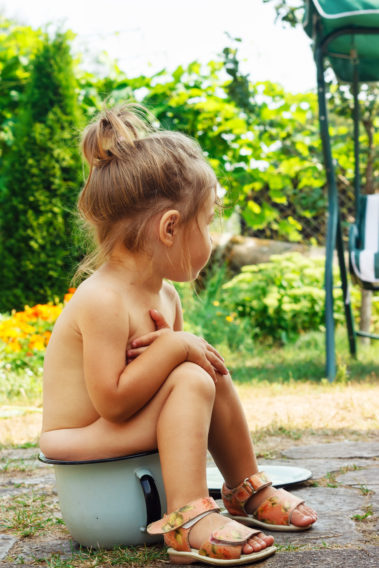
In countries like China, infants wear crotchless bottoms and their parents aim to learn to recognise the signs that their baby is about to poo or wee (a suddenly puce face, for example) and hold the baby away from their body and over a suitable receptacle. It is even more straightforward for hunter-gatherers in warm countries as there are no shopping centres, restaurants or shagpile carpets, and babies can simply be held away by their mum until they’ve finished weeing and pooing straight onto the earth.
Other solutions to cope with baby wee and poo have been developed around the world, with hoods full of arctic moss used historically to absorb the poo and wee of Inuit babies while Asian cradles called beshiks make use of a hole through which excretions are eliminated.
In the West, elimination communication is associated with an ‘attachment’ parenting style, where mums get used to the signals their baby gives for hunger, tiredness and pooing and then respond. The aim of parents using elimination communication is two-fold. First, to tap into a baby’s signals that they need to poo or wee. Second, to reduce or remove the need for nappies. That said, if you read many of the forums for elimination communication there is a big range of experience. Some parents report that it happens really easily and some parents report that they find the technique hard work and their toddler hasn’t ended up being potty trained earlier than his or her peers in nappies.
As with all things parenting, I would encourage you to try what you think will work for you and your family and not to feel pressurised by what other parents do.
I think, as with a lot of parenting techniques, there is pressure to report that it’s worked perfectly, especially if you nail your colours to the mast of a particular technique. That’s not to say that all techniques are equal but rather that human nature tends to make evangelists out of parents.
Elimination communication would perhaps best suit parents who are committed to green living, who are ‘stay at home’ (as I doubt many nurseries would offer elimination communication support as one of their services) and have a ‘go with the flow’ attitude. It requires you to be very child-centred and have bags of patience. One mother I knew who used the elimination communication potty training schedule had an immaculate house and her children wore immaculate clothes. She started elimination communication with her first baby and he ended up being very anxious around potty training as she often got frustrated and lost her cool if her toddler had an ‘accident’ (for want of a better word). Their whole world seemed to be orbiting around potty training and he even began holding in poos. Her situation highlights the need for parents to think carefully about the reality of their lives when deciding whether elimination communication is something they would like to try. Too often parents feel pressurised to follow a certain parenting expert or technique – e.g., controlled crying, elimination communication, use of the naughty step – when the advice just doesn’t suit their temperament, priorities or lifestyle.
Elimination communication is a form of behavioural conditioning, where the association between feeling a poo or wee happening is inextricably linked with sitting on a potty. Some toddlers are less easily conditioned than others; their brains simply don’t make the association as easily. This will go some way to explaining some of the range in the success of this technique from baby to baby.
Some parents’ success stories show that some babies do learn voluntary control of their bowels and bladder very early and that elimination communication facilitates the conditioning in these children.
Many parents who opt for elimination communication say they go through fewer (rather than no) nappies but it might be unrealistic to expect that all babies will respond well to the system, so be led by your child and what works best for your family.